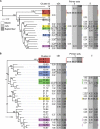Shifts in abundance and diversity of mobile genetic elements after the introduction of diverse pesticides into an on-farm biopurification system over the course of a year
- PMID: 24771027
- PMCID: PMC4054223
- DOI: 10.1128/AEM.04016-13
Shifts in abundance and diversity of mobile genetic elements after the introduction of diverse pesticides into an on-farm biopurification system over the course of a year
Abstract
Biopurification systems (BPS) are used on farms to control pollution by treating pesticide-contaminated water. It is assumed that mobile genetic elements (MGEs) carrying genes coding for enzymes involved in degradation might contribute to the degradation of pesticides. Therefore, the composition and shifts of MGEs, in particular, of IncP-1 plasmids carried by BPS bacterial communities exposed to various pesticides, were monitored over the course of an agricultural season. PCR amplification of total community DNA using primers targeting genes specific to different plasmid groups combined with Southern blot hybridization indicated a high abundance of plasmids belonging to IncP-1, IncP-7, IncP-9, IncQ, and IncW, while IncU and IncN plasmids were less abundant or not detected. Furthermore, the integrase genes of class 1 and 2 integrons (intI1, intI2) and genes encoding resistance to sulfonamides (sul1, sul2) and streptomycin (aadA) were detected and seasonality was revealed. Amplicon pyrosequencing of the IncP-1 trfA gene coding for the replication initiation protein revealed high IncP-1 plasmid diversity and an increase in the abundance of IncP-1β and a decrease in the abundance of IncP-1ε over time. The data of the chemical analysis showed increasing concentrations of various pesticides over the course of the agricultural season. As an increase in the relative abundances of bacteria carrying IncP-1β plasmids also occurred, this might point to a role of these plasmids in the degradation of many different pesticides.
Copyright © 2014, American Society for Microbiology. All Rights Reserved.
Figures

References
-
- Omirou M, Dalias P, Costa C, Papastefanou C, Dados A, Ehaliotis C, Karpouzas DG. 2012. Exploring the potential of biobeds for the depuration of pesticide-contaminated wastewaters from the citrus production chain: laboratory, column and field studies. Environ. Pollut. 166:31–39. 10.1016/j.envpol.2012.03.001 - DOI - PubMed
-
- Bers K, Sniegowski K, De Mot R, Springael D. 2012. Dynamics of the linuron hydrolase libA gene pool size in response to linuron application and environmental perturbations in agricultural soil and on-farm biopurification systems. Appl. Environ. Microbiol. 78:2783–2789. 10.1128/AEM.06991-11 - DOI - PMC - PubMed
Publication types
MeSH terms
Substances
Associated data
- Actions
- Actions
- Actions
- Actions
- Actions
- Actions
- Actions
- Actions
- Actions
- Actions
- Actions
- Actions
- Actions
- Actions
LinkOut - more resources
Full Text Sources
Other Literature Sources
Medical
Research Materials

